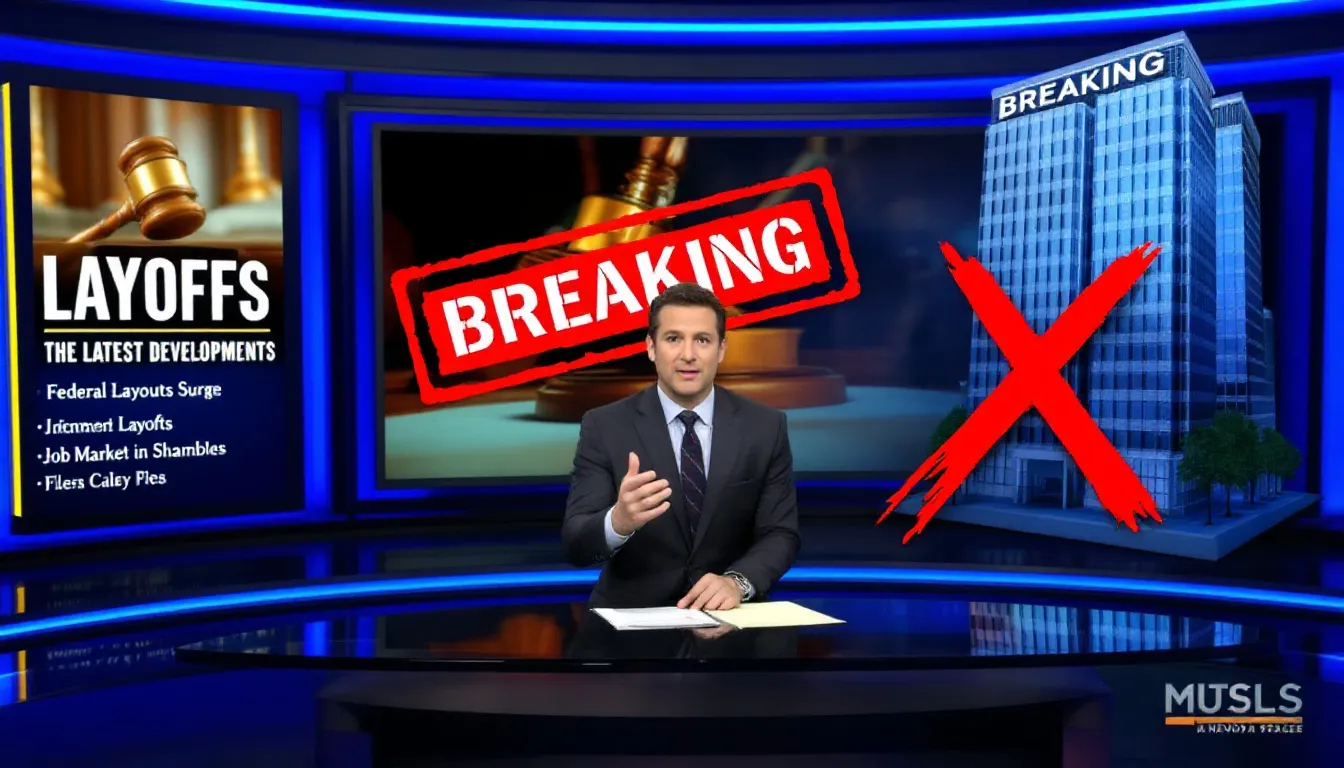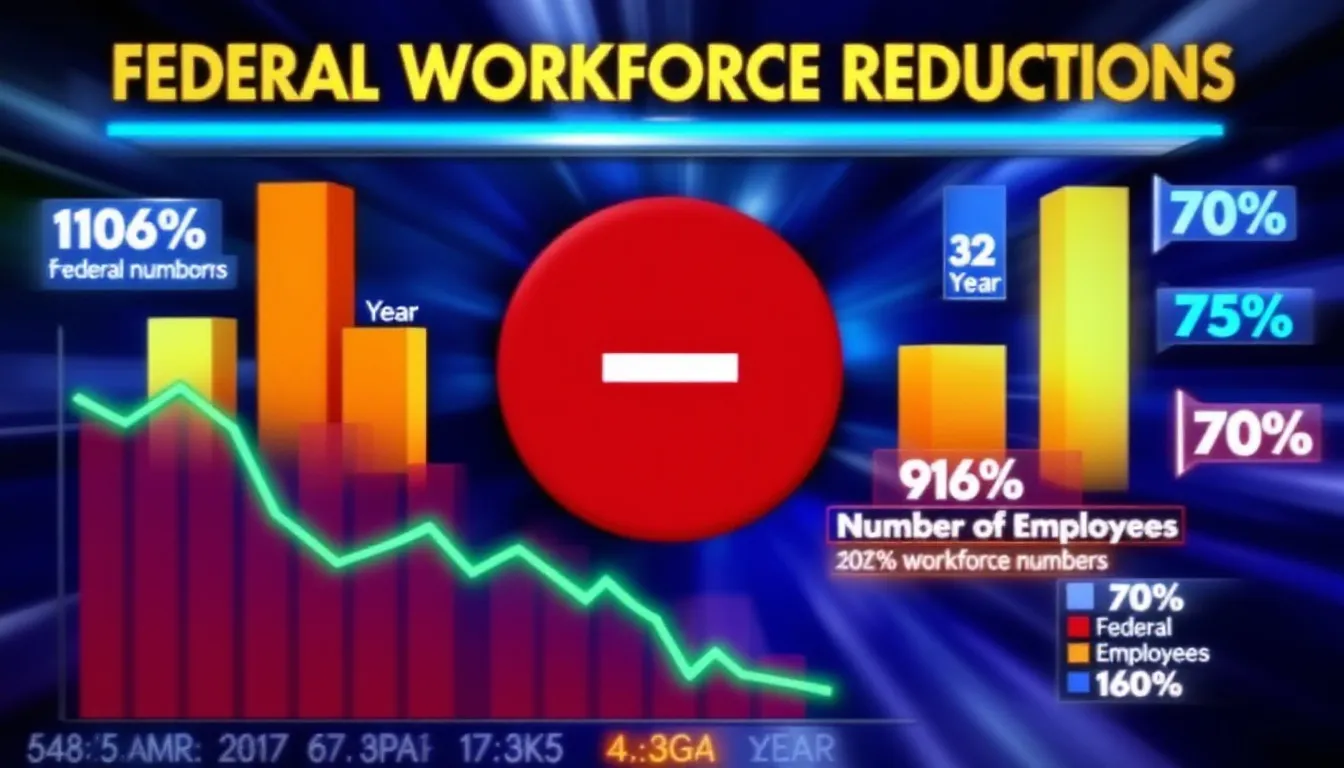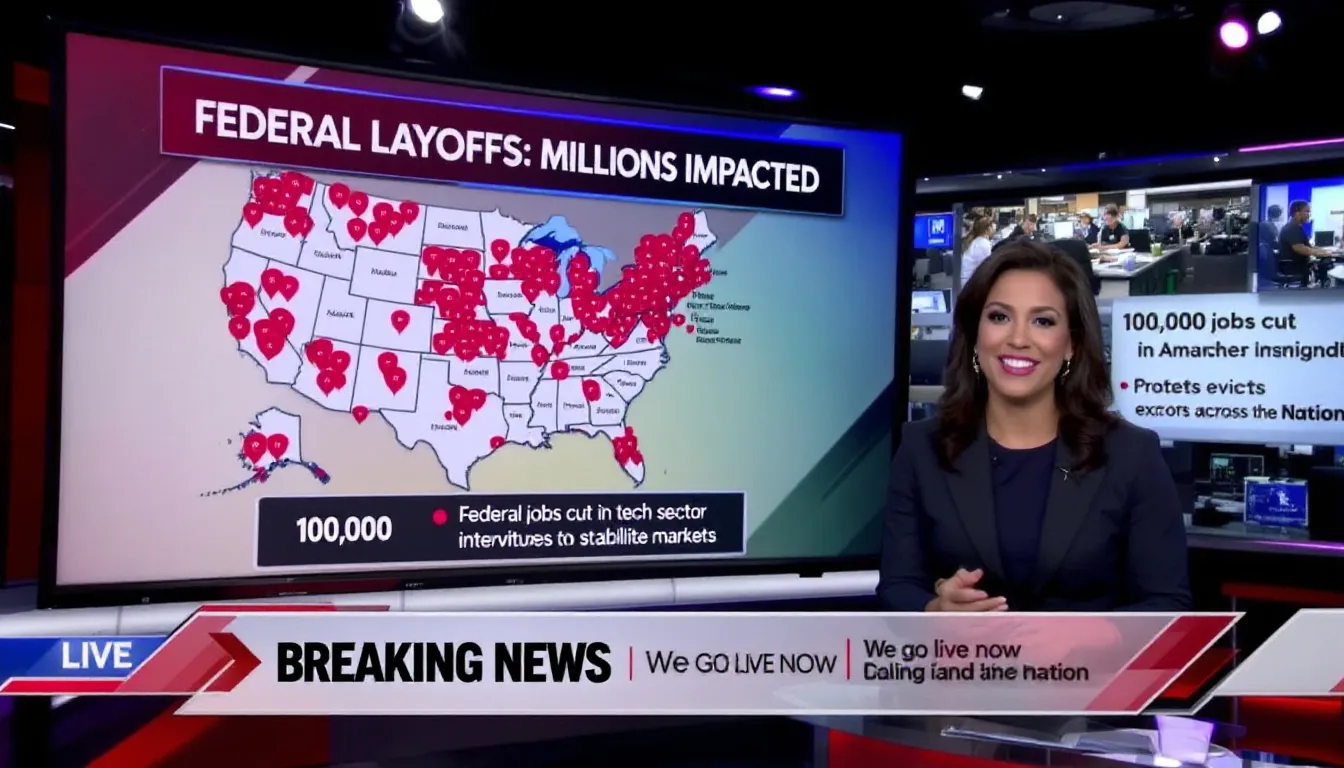Fednews are our vital updates and resources for federal employees facing layoffs or job uncertainty. Discover the latest timeline of federal layoffs, key legal challenges, and agency impacts. Stay informed on executive orders and learn how to navigate your career amid these changes. For the latest, on March 13, a federal judge ordered the administration to reinstate thousands of probationary employees: https://abcnews.go.com/Politics/judge-order-fired-probationary-federal-employees-reinstated/story?id=119759494
Key fednews Takeaways
- Federal layoffs under the Trump administration have led to job insecurity for tens of thousands of federal workers, driven by executive orders promoting significant workforce reductions.
- Legal battles are ongoing, focusing on the legitimacy of layoffs and employee rights, with notable rulings indicating potential unlawfulness in the termination of probationary workers.
- The future remains uncertain for federal employees, with anticipated cuts and policy changes heightening anxiety, while legislative efforts aim to enhance job security and protections.
The Timeline of Recent Federal Layoffs

The recent weeks have been a whirlwind for federal employees, with the Trump administration implementing significant and impactful changes. The timeline for these federal layoffs has been marked by a series of executive orders and legal battles, reshaping the landscape of federal employment. Tens of thousands of employees are expected to be terminated, reflecting a dramatic shift in the federal workforce.
Federal workers have faced a tumultuous period with notice periods for layoffs ranging from 30 to 60 days, creating an atmosphere of uncertainty and anxiety. These changes have been influenced by legislative and executive decisions, setting the stage for a series of events that have left many government employees in limbo.
The following sections will delve deeper into the specific actions, legal challenges, and impacts on federal agencies.
Executive Orders and Initial Actions
The Trump administration’s approach to federal employment has been characterized by a series of bold executive orders. One of the most notable actions was the revival of Schedule F through an executive order signed by President Trump, which created at-will positions for nonpartisan career civil servants, effectively stripping them of job protections.
Another significant move was the executive order signed on January 20, which aimed to block the hiring of federal civilian employees in the executive branch. In addition to these orders, President Trump instructed the heads of federal departments to plan for large-scale reductions in force, signaling a significant downsizing of the federal workforce.
Federal employees were given buyout offers, including eight months of pay and benefits if they resigned by February 6, with warnings of potential furloughs if they did not accept. Exemptions from these planned layoffs included U.S. Postal Service workers, law enforcement, national security, and military personnel, highlighting the selective nature of these workforce reductions.
Legal Battles and Court Rulings
The sweeping layoffs have not gone unchallenged. Labor unions have actively argued that these mass terminations violate employee rights and exceed the Office of Personnel Management’s (OPM) authority. One of the primary allegations in the unions’ lawsuits was the misuse of the probationary period to eliminate staff, with claims that termination notices falsely cited performance issues.
Judge William Alsup played a crucial role in these legal battles, ruling on February 27 that the firings of probationary employees were likely unlawful and blocking them. He emphasized that OPM lacks the authority to hire or fire any employees, casting doubt on the legality of the administration’s actions.
These court rulings have added a layer of complexity to the already fraught situation, providing a glimmer of hope for affected federal workers.
Impact on Specific Agencies
The impact of these layoffs has been felt acutely across various federal agencies. One of the most severely affected was the U.S. Agency for International Development (USAID), where nearly all employees were placed on leave or terminated, severely hampering its operational capacity. This has raised concerns about the agency’s ability to fulfill its mission effectively.
For federal workers looking to contest their dismissals, the Office of the Special Counsel serves as the main avenue for seeking redress. However, the scale and speed of these layoffs have left many employees scrambling for solutions, underscoring the need for robust legal and administrative support systems.
Legal and Administrative Developments

The legal and administrative landscape surrounding federal employee terminations has been in a state of flux. Recent developments have highlighted concerns about executive overreach and compliance with federal regulations. The dismissal of Special Counsel Hampton Dellinger, for instance, has raised questions about adherence to federal laws concerning employee terminations.
After a prolonged legal battle, Dellinger chose to terminate his lawsuit, citing the risk of prolonged disputes as detrimental to his ability to serve effectively. This case reflects broader concerns about the balance of power between the administration and federal employees.
The following subsections will explore the roles of the Office of Personnel Management, the Merit Systems Protection Board, and the responses from states and unions.
Office of Personnel Management’s Role
Charles Ezell, the acting head of OPM, has been a key figure in managing the federal workforce changes. His leadership has focused on ensuring compliance with federal regulations during the layoffs. Despite the administration’s stance that firing decisions regarding probationary workers are up to the agencies, Ezell has navigated the challenges posed by these workforce reductions.
Following a judge’s ruling, OPM edited its guidance to clarify that it never required agencies to take specific actions regarding probationary employees. This move underscored the agency’s discretion in personnel decisions and highlighted the complexities of managing large-scale layoffs within the federal workforce.
Merit Systems Protection Board Decisions
The Merit Systems Protection Board (MSPB) has played a crucial role in interpreting employee rights and ensuring fair treatment during the recent layoffs. One of the most significant rulings mandated the reinstatement of close to 6,000 USDA employees, with the board finding that their terminations were likely unjustified. This decision underscored the importance of procedural fairness and adherence to legal standards.
Judicial opinions regarding the firings of federal employees have highlighted the need for transparency and proper legal grounds for dismissals. The MSPB’s recent rulings emphasize the requirement for transparency and adherence to laws governing large-scale layoffs in government, providing a crucial check on executive actions.
State and Union Responses
The response from states and unions has been robust, with a coalition of states initiating legal actions to challenge the fired federal employees by the federal government. These states argue that the firings were illegal, contending that the administration ignored laws required for large-scale layoffs, which could significantly impact state finances.
The states involved in the lawsuit against the Trump administration include Arizona, California, and Colorado, among others, forming a significant coalition. Unions have also taken legal actions aimed at safeguarding federal employees against broad termination policies, reflecting the widespread concern and opposition to these layoffs.
Federal Workforce Reductions: By the Numbers

The sheer scale of the recent federal workforce reductions is staggering. The Trump administration has made significant cuts, with over 16,000 probationary employees laid off. The impact on agencies like the U.S. Agency for International Development (USAID) has been particularly severe, with its workforce reduced from over 10,000 employees to just a few hundred.
These reductions have led to widespread uncertainty and anxiety among federal employees. The following subsections will delve into the specifics of buyout offers, probationary employee firings, and projected workforce cuts, providing a comprehensive overview of the numbers behind these layoffs.
Buyout Offers and Acceptance Rates
Amidst the workforce reductions, a significant number of federal employees have opted for buyout offers. Approximately 75,000 federal employees accepted President Trump’s buyout offer, which is about 3.3% of the federal government’s 2.3 million workers. This acceptance rate, however, fell below the White House’s projections of 5% to 10%.
The lower-than-expected acceptance rate reflects the uncertainty and reluctance among federal employees to leave their positions. Despite the allure of eight months of pay and benefits, many workers chose to stay, hoping for a more stable future in their current roles.
Probationary Employee Firings
Probationary employees have been particularly targeted during these workforce reductions. There are currently approximately 250,000 federal employees on probationary status. The plaintiffs in the legal battles estimated that at least 24,000 probationary employees have been terminated since the layoffs began. The government, however, reported that roughly 200,000 probationary employees have been let go as part of these reductions.
These layoffs primarily affected new employees and those with less than two years of tenure. OPM’s recent guidance clarified that it does not have the power to mandate terminations in federal agencies, emphasizing agency discretion in personnel decisions. This has added another layer of complexity to the ongoing legal and administrative challenges.
Projected Workforce Cuts
The projected workforce cuts paint a grim picture for the future of federal employment. Planned reductions include the termination of 76,000 workers from the Department of Veterans Affairs and 1,300 workers from the Department of Education. The Education Department announced plans to cut about half of its staff, reflecting the scale of these reductions.
Agencies such as USAID and the Consumer Financial Protection Bureau are also facing significant layoffs. The Trump administration has discussed a 65% workforce cut for the Environmental Protection Agency.
These projections highlight the need for careful planning and support for affected employees, as the federal workforce braces for further reductions.
Key Figures and Testimonies

The narrative of federal layoffs is incomplete without acknowledging the key figures and their testimonies that have shaped this process. Charles Ezell, as the acting head of OPM, has been pivotal in managing the layoffs and justifying the changes to federal workforce policies. His leadership has been marked by efforts to navigate the challenges posed by these reductions.
The termination of Hampton Dellinger, who served as Special Counsel, has raised concerns about the administration’s commitment to fair employment practices for federal workers. Judicial commentary has also provided critical insights into the legality of the administration’s actions, emphasizing the need for due process in terminations related to the layoffs.
The following subsections will delve deeper into the roles and testimonies of these key figures.
Charles Ezell and OPM Leadership
Charles Ezell has played a significant role as the acting director of the Office of Personnel Management (OPM), particularly during a time marked by significant layoffs and restructuring within the federal workforce. Ezell’s responsibilities have included guiding the agency through the complexities of the workforce transitions and ensuring compliance with federal regulations. His leadership has been crucial in navigating the challenges posed by these reductions, emphasizing the importance of adhering to legal standards.
A federal judge ordered Charles Ezell to testify at a court hearing examining the legality of the Trump administration’s mass firings of federal employees. This testimony has been pivotal in shedding light on the administration’s actions and the procedural fairness of the layoffs, highlighting the ongoing legal and administrative scrutiny.
Special Counsel Hampton Dellinger’s Firing
The firing of Hampton Dellinger, who served as Special Counsel, has been a significant point of contention. Dellinger was dismissed amid controversies surrounding his leadership, raising legal and ethical questions. He contended that his dismissal violated federal law, which restricts the firing of special counsels to instances of inefficiency or misconduct.
Dellinger’s lawsuit references a 1978 federal law that he claims was violated during his dismissal. The Trump administration plans to replace him with the Veterans Affairs Secretary, adding another layer of complexity to the already contentious situation.
This case underscores the broader concerns about executive overreach and the adherence to federal laws concerning employee terminations.
Judicial Perspectives
Judicial perspectives provide critical insights into the legal battles surrounding federal layoffs. Several notable court rulings have established precedents affecting employee protections and the legality of the administration’s layoff procedures. Judges presiding over these cases have emphasized the need for due process for affected federal employees, highlighting the importance of procedural fairness and transparency.
The outcomes of these judicial rulings may influence future policy decisions and the treatment of federal employees during workforce reductions. The ongoing legal scrutiny underscores the need for careful and fair implementation of layoffs, ensuring that employee rights are protected.
Impacts on Federal Employees

The impacts of the recent layoffs on federal employees have been profound. Many have found themselves on administrative leave or furloughs, facing an uncertain future. The Trump administration has begun mass firings of permanent federal employees, with expectations of accelerating these layoffs in the coming weeks. The Office of Personnel Management (OPM) has had to revise its guidance on terminating probationary employees after a court ruling challenged its authority.
The Merit Systems Protection Board’s decisions have been essential in interpreting employee rights and ensuring fair treatment during the reinstatement process. The following subsections will explore the specific impacts of administrative leave and furloughs, reinstatements and back pay, and the long-term career implications for federal employees.
Administrative Leave and Furloughs
During the layoff process, agencies often utilize administrative leave and furloughs as temporary measures to manage workforce reductions. These measures have been a double-edged sword for federal workers. On one hand, they provide temporary relief from immediate termination, but on the other, they leave employees in a state of limbo, uncertain about their future prospects.
Federal employees placed on administrative leave or furloughs are often left waiting for resolution, with their job security hanging in the balance. This uncertainty can lead to increased stress and anxiety, affecting their overall well-being and productivity.
Reinstatements and Back Pay
There have been instances where federal employees, after successfully contesting their terminations, have been reinstated with back pay. The USDA, for example, announced that it would place recalled employees on paid administrative leave and provide back pay to the date of their termination. This move has been a significant relief for many affected workers, ensuring they are compensated for the period they were unjustly laid off.
Federal employees who were wrongfully terminated and subsequently reinstated have also benefited from decisions by the Merit Systems Protection Board. These decisions have underscored the importance of procedural fairness and the adherence to legal standards during layoffs. Such rulings provide a crucial check on executive actions, ensuring that employee rights are protected.
Long-Term Career Implications
The long-term career implications for federal employees affected by the layoffs are significant. Many who chose to stay despite the buyout offers have faced increased uncertainty and stress regarding their future roles. The acceptance of buyout offers has been significantly lower than expected, with many employees opting to remain in their positions. This decision reflects the hope for stability and the desire to continue serving the public.
However, staying in their positions could lead to potential long-term job security concerns. The ongoing policy changes and workforce reductions have raised questions about the stability of federal employment, leaving many employees worried about their future. This uncertainty can impact their morale and overall job performance, highlighting the need for supportive measures and clear communication from the administration.
Future Outlook for Federal Workforce
The future outlook for the federal workforce remains uncertain, with significant reductions and policy changes on the horizon. Federal employees are experiencing significant stress and anxiety due to the ongoing layoffs and changes in policies. The anticipated shifts towards greater flexibility and remote work options may provide some relief, but the overall job insecurity continues to loom large.
Recent layoffs and policy changes have led to increased job insecurity among federal workers, impacting their mental health and morale. The following subsections will explore upcoming executive orders, legislative efforts, and agency plans and preparations, providing a comprehensive overview of what lies ahead for the federal workforce.
Upcoming Executive Orders
Anticipated executive orders could reshape the landscape of federal employment policies in significant ways. Two key executive orders are expected to focus on workforce reductions and restructuring of federal agencies. If enacted, these orders could lead to increased job insecurity among federal employees and potential layoffs.
The implementation of these executive orders may significantly alter job roles and employment stability for federal workers in the senior executive service. The administration’s focus on national security and efficiency could drive these changes, further impacting the federal workforce’s future.
Legislative Efforts
Current legislative initiatives aim to enhance job security for federal employees, addressing both workforce reforms and employee protections. Lawmakers are proposing bills to strengthen job protections, prevent unjust terminations, and provide better workplace rights.
These legislative efforts reflect a bipartisan recognition of the need to modernize workforce policies and adapt to current needs. Recent proposals focus on safeguarding job security for federal employees amid potential reductions in workforce size, ensuring that their rights and interests are protected.
Agency Plans and Preparations
The Office of Personnel Management (OPM) is involved in setting guidelines for federal workforce management, especially during layoffs. Current guidelines emphasize the need for structured management of layoffs to minimize disruption and provide support to affected employees.
Future projections indicate substantial workforce cuts across various federal agencies, impacting thousands of employees. Some agencies are preparing for cuts of up to 70%, reflecting the ongoing strategy for workforce reduction. These plans underscore the need for careful planning and support mechanisms to help federal employees navigate these challenging times.
Summary
In summary, the recent federal layoffs have brought significant changes and challenges to the federal workforce. The timeline of events, driven by executive orders and legal battles, has reshaped the landscape of federal employment. Key figures like Charles Ezell and Hampton Dellinger have played pivotal roles, while judicial perspectives have emphasized the need for due process and fairness.
Looking ahead, federal employees face an uncertain future with anticipated executive orders, legislative efforts, and agency plans for further workforce reductions. Navigating these changes requires staying informed and proactive, understanding the legal and administrative developments, and seeking support where needed. The resilience and dedication of federal employees will be crucial in overcoming these challenges and continuing to serve the American people.
Frequently Asked Questions
How many federal employees accepted Trump’s buyout offer?
Around 75,000 federal employees took Trump’s buyout offer, making up about 3.3% of the 2.3 million federal workforce.
What is the expected impact of the planned reductions in the federal workforce?
The planned cuts could seriously impact services, with the loss of 76,000 jobs at the VA and over 1,000 at NOAA potentially straining operations and support for many. It’s a big shake-up that could affect everyday folks relying on these services.
What regulations must the administration follow during large-scale reductions in force?
The administration has to take into account factors like tenure, performance, and veteran status when laying off employees, and usually, they need to give a 60-day heads-up. So, if layoffs are on the table, you can expect some careful consideration and notice.
What did a federal judge in California find regarding the instructions to fire probationary workers?
A federal judge in California deemed the instructions to fire probationary workers “illegal” and said they should be taken back. So, it looks like those orders might not hold up after all!
What did the coalition of states argue regarding the firings?
The coalition of states argued that the firings were illegal and pushed for a temporary restraining order to revert things back to how they were before.



